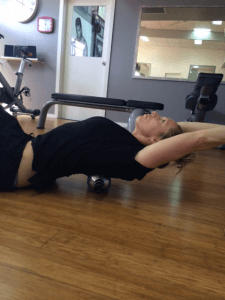Do you get neck pain after an overhead-dominant workout?
Are you a headache sufferer?
Spend all day working on a computer?
If you answered yes to any or all of the above questions, you may be suffering from Upper Cross Syndrome aka Poke Neck!
 |
| Upper Crossed Syndrome aka Poke Neck |
What is Upper Crossed Syndrome?
Poke neck can be the result of shoulder/upper thoracic mobility issues and/or weakness of the deep neck muscles and scapular stability muscles, otherwise known as Upper-Crossed Syndrome. This syndrome is particularly evident in people who have desk/computer jobs. It has been found that for every inch (or 2.54cm for the metric peeps) your head is forward of your spine, an additional 10lbs (or 4.5kg) is added to the weight of your head (Kapandji, 2008). This additional weight places stress on the muscles of the neck and upper back and can put extra pressure on the suboccipital nerves, causing headaches.
To combat poke neck, mobilize the following areas:
– Thoracic spine
– Neck: particularly upper traps, levator scapula & scalenes
– Chest: pectoralis major/minor
The following two stretches can be found in the MobilizeMe App.

Thoracic Extension Over Roller

Pec Minor Stretch
Strengthen These to help with your posture:
– Deep neck flexors
– Middle back: lower trapezius & rhomboids (Bulletproof shoulders by Crossfit New England is a great resource).
In addition, have a look at your biomechanics while you are training. Get your coach to film you from the side the next time you are doing a pressing movement, kettlebell swings or thrusters/overhead squat to see if you are excessively throwing your head through at the top of the movement.
Need a Physio to check your form? MobilizeMe Physio on the Gold Coast offers FREE initial assessments for new clients with your private health. Book today!
